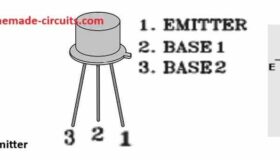In this article I will explain a simple curtain controller circuit designed by me, which can be used to control the opening and closing of a curtain through a remote […]
New Circuit Projects
Convert any H-Bridge Inverter to Sine Wave H-bridge Inverter
In this post we’ll discuss how to convert any ordinary square wave H-bridge inverter into an almost pure sine wave inverter circuit. Basic Concept The idea is simple, just chop […]
Pump Motor Timer Circuit with Dry Run Protection
In this post I have explained about a circuit which can be used to monitor and detect the presence of municipal water supply by operating a pump motor through an […]
Automatic Door Controller Circuit using a Single Push-Button
Automatic Door Controller Circuit using a Single Push-Button
Unijunction Transistor (UJT) 2N2646 Datasheet
The 2N2646 is a type of Unijunction Transistor (UJT), which is commonly used in various oscillator based electronic circuit application. The following paragraphs provide the datasheet and the main specifications […]
IC LM358 Datasheet and Specifications
In this post you will find the complete datasheet, pinout specifications of the IC LM358. This datasheet is written in simple language so that even the new hobbyists are able […]





